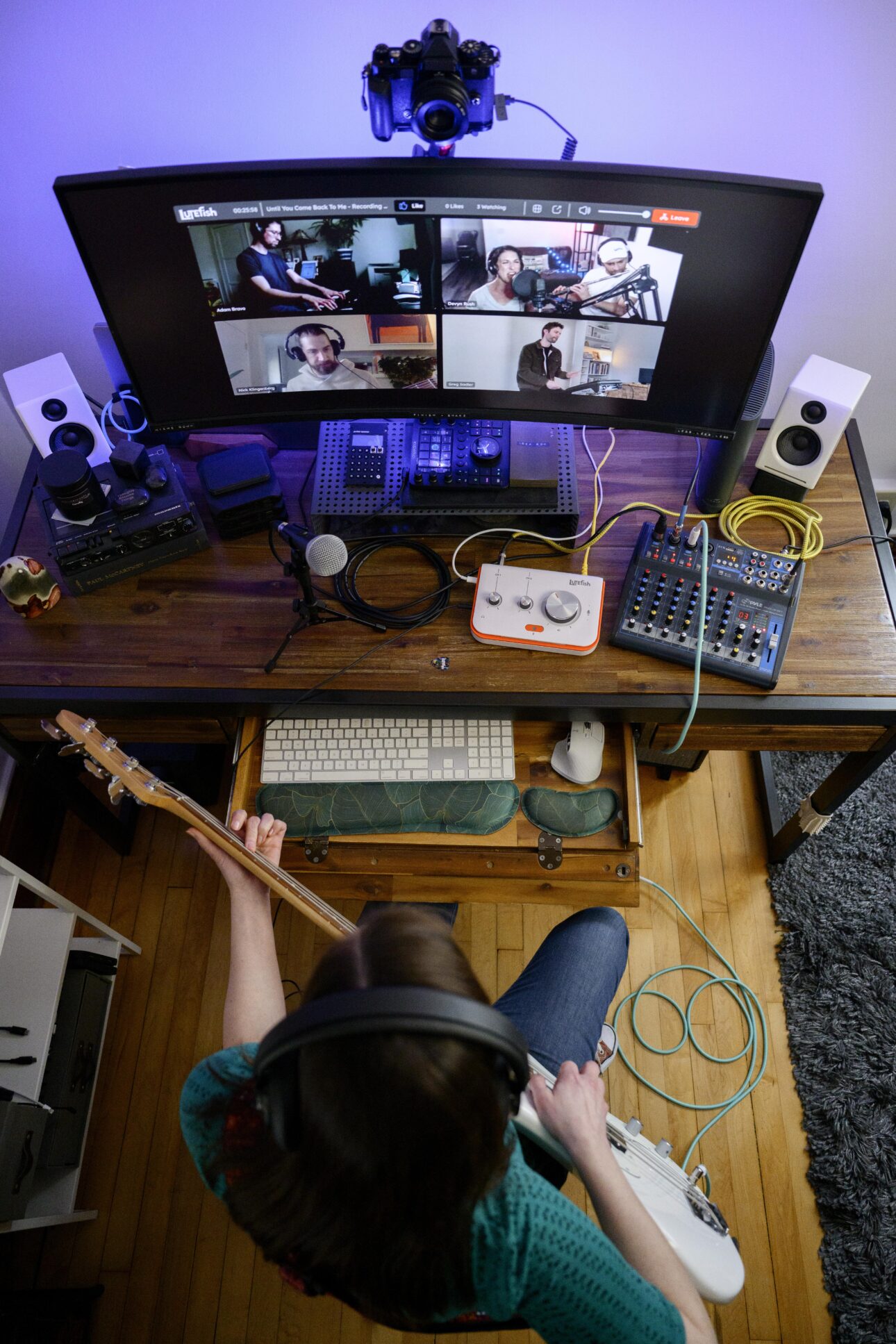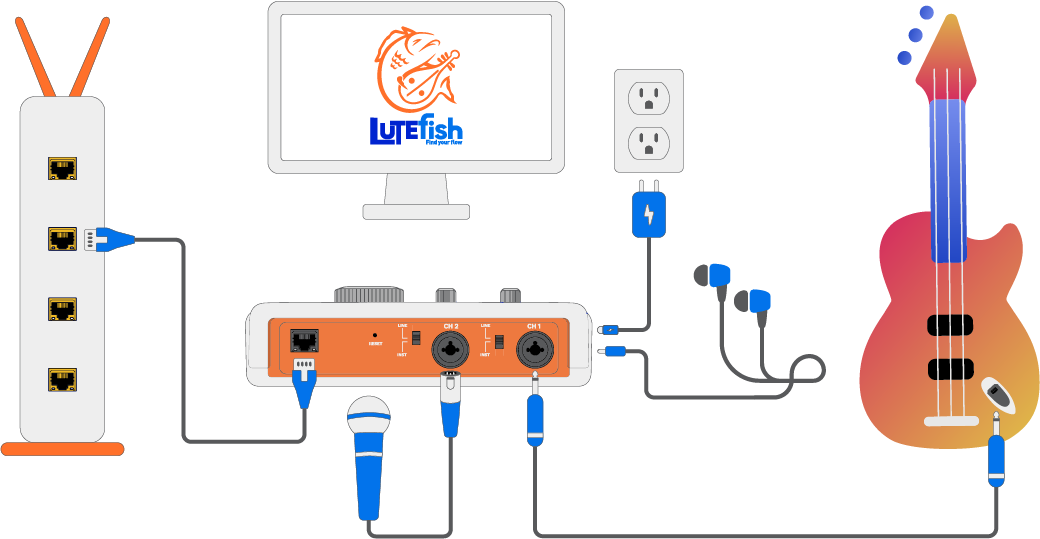During the pandemic, we all got a hall pass to do remote work, mostly using Zoom to connect with coworkers, clients, friends, and even family members. But if you were a musician in a band, being remote created a particularly unique set of challenges. There were online music collaboration platforms and hacks out there at the time, yet most of them had quirks such as network latency delays, poor audio, and internet instability.
The Virtual Jam Revolution Is Here
Today, there is something that actually works: an advanced streaming solution that allows you to play with other musicians without the usual audio hiccups, workarounds, and lag time of previously released products. Think of the new online music collaboration platform, Lutefish, as a highly effective Zoom for musicians. It uses a dedicated hardware device that allows musicians to play in real-time jam sessions with players streaming in from as many as five different locations. The company advertises that musicians can be up to 500 miles apart, but some users report on social media that they can be 1,000+ miles away and still practice seamlessly. That creates a lot of new possibilities.
More from Spin:
- X and Los Lobos: Celebrating ‘99 Years of Rock n’ Roll’ Together
- 5 Things Everyone in the Music Industry Should Know
- Now Hear This: July 2025
But how big of an impact does Lutefish have for musicians? Orange County thrash metal band Trip To The Morgue has been experiencing a resurgence in popularity, leading to a very hectic schedule. They just signed to a new record label and are releasing an album, alongside maintaining a relentless national touring schedule. Recently, they needed to audition for a new backup guitarist, and found one who lived in Las Vegas, Nevada, while they remain in Orange County, California – a state away. Lead guitarist, James Patrick McCosar, explains that Lutefish was essential for helping the band adapt to their crazy scheduling, auditioning new faraway guitarists, finding one, then practicing together from different locations.
“So it was just in the nick of time that Lutefish came within our possession to be able to say this is going to work out perfectly… It’s been super easy for us to not only collaborate on working with a new guitar player, but also with being able to write new music and being able to practice and get things up to speed for everything that’s happening so quickly.” In fact, the band went from practicing online with their new guitarist on Lutefish straight into a live show in Las Vegas. They had never once had a face-to-face practice session. “It was seamless,” adds McCosar. Check out the band’s full online jamming experience on the Lutefish blog.

Where Remote Rehearsals Meet Real Connections
In addition to real-time collaboration, the Lutefish platform (sign up is free) connects users to a music community where they can meet like-minded musicians, find people to jam with, and even find new band members. Musicians and artists can also find gigs in their area and promote projects and shows. There are other musician-focused social platforms, but the difference is Lutefish users can start playing together right away, provided they’ve purchased the hardware. The platform allows people to share their music with the community, discover and play with strangers who have similar musical abilities, form a new band, or simply jam with new and old friends who live far away. Lutefish’s technology also eliminates the time-suck of packing up and moving musical equipment and setup for band practice in yet another physical location. That’s a lot of benefits.
The platform also has a great track record with frequent updates and new features. The following features are all slated to arrive within the year:
- Stem Recording (aka multi-tracking) allows groups to record their individual audio streams separately, enabling more capacity for post-processing sessions.
- Live Streaming, musicians can livestream their performance to an audience.
- In-platform audio and video performance recording allows musicians to record audio and video from a performance, then adjust the start and end time of the media – all within Lutefish.
Here’s Why This Hardware Wins
Lutefish’s plug-n-play platform outperforms streaming platforms released in the past that relied on Wi-Fi and additional computer software to connect with remote players. If chat rooms are to be trusted, especially on Reddit, these other platforms exhibit a lot of issues with reliability, loss of live audio quality, time delays, and lack the ability to record with clarity and edit effectively. Lutefish’s hardware, the Lutefish Stream, connects directly to your router using an Ethernet cable to deliver ultra-low latency and clear audio through high-quality preamps as if you’re standing 30 feet away from other players. If you want to get really technical, that means devices can stream 48k audio with less than 30 milliseconds of latency. This helps reduce connectivity issues and lag times, allowing musicians to rehearse and record together via the Internet while being in sync.

Having dedicated hardware is a big part of what sets Lutefish apart, as it provides the platform with key technical benefits:
- The operating system is optimized solely for real-time audio processing
- Third-party products and software like audio interfaces DAWs are not needed.
- Audio paths are tightly managed to prevent unpredictable slowdowns.
These technical advantages are really what make Lutefish feel more like an in-person playing experience.
Based in Minnesota, not Silicon Valley, Lutefish says it was founded “by musicians for musicians” who created the technology to enable players of all abilities to share in the joy of making music together. And if you’re looking for Minnesota’s music cred, the star of the north state lays claim to Lizzo, Prince, Bob Dylan, The Replacements, and Babes in Toyland, just to name a few.
Lutefish founders explain, “We built Lutefish as a dedicated hardware unit to eliminate as many sources of latency and variability as possible, while providing an easy plug-and-play platform.”
Skip the Tech Headaches—Here’s How It Works
1. Purchase the Lutefish unit ($299 USD).
2. Activate your subscription ($12.99 USD/month, including 2 free months).
3. Plug in your gear and start jamming instantly.
Once you have the hardware, simply plug it into power, connect it to your router via Ethernet, and then plug in your instrument and mic. Connect to the Internet through the Ethernet cable and fire up the app to connect face-to-face with five other performers in five different locations.
Lutefish offers all the positives for a remote band experience in one product. Once you and your bandmates are on Lutefish, you won’t need to leave your house or studio to make and play quality music. Unless, of course, you get signed to a major tour. Then rock on!
To see our running list of the top 100 greatest rock stars of all time, click here.



